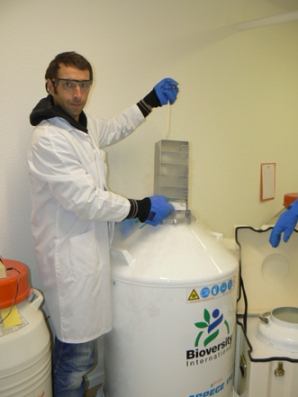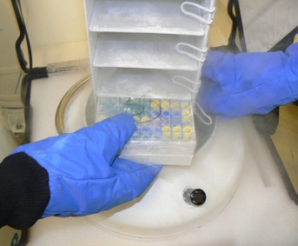Cryo storage for banana genetic resources
.jpg)
View the full publication on Cryopreservation of Musa germplasm by clicking on the icon above |
Contributors to this page: Bioversity International, Belgium (Bart Panis).
The contents of these Cryo pages were extracted from Panis B. 2009. Cryopreservation of Musa germplasm: 2nd edition. Technical guidelines No.9 (F. Engelmann and E. Benson, eds). Bioversity International, Montpellier, France.
Introduction
In the last 20 years, several new cryopreservation procedures like vitrification, encapsulation-dehydration, preculture-dehydration, and encapsulation vitrification have been established, which are all based on vitrification. Vitrification can be defined as the transition of water directly from the liquid phase into an amorphous phase or glass, whilst avoiding the formation of crystalline ice. Cryopreservation protocols based on vitrification techniques have been developed for different vegetatively propagated crops, including banana (Sakai and Engelmann 2007).
When cryo banks are used
|
‘Cryopreserving’ samples or placing samples into a state of suspended animation in liquid nitrogen (photo: Bioversity) |
|
|
A box containing cryotubes (photo: Bioversity) |
Research on cryopreservation of Musa was initiated in the 1990ties at Bioversity International Transit Center (ITC, previously INIBAP). The main objective was to:
- Overcome some of the limitations of in vitro maintenance (labour-intensive subculturing, potential for fungal and bacterial contaminants, as well as the risk for somaclonal variation).
- To ensure the safe long-term conservation of Musa genetic resources.
Current situation
Bioversity-supported research at KULeuven has resulted in the development of three cryopreservation protocols suitable for the long-term storage of meristem cultures of banana.
- The first method relies on rapid freezing of highly proliferating meristem cultures, precultured for two weeks on medium with 0.4 M (136.8 g/L) sucrose.
- The second method also uses highly proliferating meristem cultures that are precultured on sucrose but they receive an additional vitrification treatment.
- The third and most generally applicable protocol is the vitrification of apical meristems excised from rooted in vitro plants.
The labour requirement to cryopreserve accessions, as well as the post-re-warming regeneration percentages, depends on the cultivar and the method used (Panis et al. 2007).
The application of the aforementioned protocols has resulted thus far in the safe storage in liquid nitrogen of 882 accessions (situation September 2013) belonging to the different genome groups within the genus Musa.
Detection of endophytic bacteria
During normal meristem culture and storage under limited growth conditions, the presence of endogenous bacteria is rarely observed. If present, often such bacteria do not interfere with the growth of meristem cultures. However, as soon as meristems are subjected to cryopreservation, growth of endogenous bacteria becomes a problem. As the meristems begin to regrow following cryopreservation, endogenous bacteria present can develop into yellow or white colonies, which overgrow the recovering meristem.
- Prior to cryopreservation, cultures should always be screened for the presence of endophytic bacteria on a bacterial growth medium (BACT medium) containing 23 g/L Difco® Bacto nutrient broth, 10 g/L glucose and 5 g/L yeast extract (van den Houwe and Swennen 2000).
- The plates should be incubated for three weeks in the light at 28°C.
- Accessions with a positive response to bacterial screening should be discarded (Hamill et al. 2005, Thomas et al. 2008, Van den Houwe and Swennen 2000).
Method of cryopreservation at the ITC
- Currently, the droplet-vitrification of apical meristems, as well as the droplet-vitrification of ‘cauliflower-like’ meristem clusters, are both applied to the Musa collection.
- The simple freezing method is no longer applied for these purposes in view of the relatively low post-thaw regeneration percentages obtained for most genomic groups.
The table below compares the labour requirement for the two methods that are now applied.
Table: Comparison of labour requirement for two cryopreservation protocols.
|
Freezing method |
Labour time |
cvs/person |
Time needed |
Cultivars |
|
Vitrification of proliferating clumps |
30 to 40 |
59 to 44 |
12 to 13 |
ABB |
|
Vitrification of individual meristems |
60 to 70 |
29 to 25 |
8 to 9 |
AAAh bananas |
|
1: Calculated time needed to prepare the culture media and meristem cultures followed by cryopreservation. |
||||
- The most labour intensive method (vitrification of apical meristems excised from rooted in vitro plants) should only be applied to the cultivars which are difficult to cryopreserve with the other method (for example AAA highland bananas).
- For banana accessions belonging to the ABB group and AAB (non-plantain) bananas, the droplet-vitrification of proliferating clumps is always applied.
- The preferred method for Musa acuminata and the East African highland bananas is the droplet-vitrification of apical meristems.
- For all other accessions, the method of choice is based on (i) the proliferation degree of the meristem clumps that are obtained after three subculture cycles on a medium containing high cytokinin concentrations and (ii) survival of the proliferating meristem clumps after a preliminary cryopreservation trial.
To decide whether a cryopreservation experiment is successful or not, the mode of calculation developed by Dussert and coworkers (2003) should be used. These calculations have been applied to all ITC data.
An experiment is considered successful provided that the chance to regenerate at least one shoot from the stored material is more than 95%. This probability depends on:
(i) the number of explants stored in liquid nitrogen (in the long-term ranging between 30 and 50);
(ii) the number of explants re-warmed (ranging between 16 and 50); and
(iii) the post re-warming regeneration percentage (%).
An experiment leading to a lower probability level will not be considered successful, irrespective of its regeneration percentage. In such cases, the repetition is discarded and a new repetition will be executed.
A banana accession is considered “safely” preserved if three independent (and successful) experiments are completed. According to these requirements, ITC is currently storing 882 accessions belonging to 30 different genomic banana groups in liquid nitrogen (situation September 2013).
References and further reading
Agrawal A, Swennen R, Panis B. 2004. A comparison of four methods for cryopreservation of meristems in banana (Musa spp.). CryoLetters 25:101-110.
Hamill S, Wasmund K, Smith M, Eccleston K, McKay D. 2005. Endogenous bacterial isolated from banana meristems during tissue culture initiation: problems and potential. In: Benett IJ, Bunn E, Clarke H, McComb JA. editors. Contributing to a Sustainable Future. Proc. Australian Branch IAPTC & B. Perth, Western Australia, AU. pp.101-111.
Panis B. 2009. Cryopreservation of Musa germplasm: 2nd edition. Technical Guidelines No. 9 (F. Engelmann and E. Benson, eds). Bioversity International, Montpellier, France. Available here.
Panis B. 2008. Cryopreservation of Monocots. Chapter 11. In: Reed BM, editor. Plant Cryopreservation: A Practical Guide. Springer Science+Business Media, LLC. pp. 241-280.
Panis B, Helliot B, Strosse H, Remy S, Lepoivre P, Swennen R. 2005. Germplasm conservation, virus eradication and safe storage of transformation competent cultures. In: Chang WC, Drew R, editors. Banana: The importance of cryopreservation. Proceedings IInd IS on Biotech. of Trop. & Subtrop. Species. Acta Horticulturae 692. ISHS. pp. 51-59.
Panis B, Lambardi M. 2006. Status of cryopreservation technologies in plants (crops and forest trees). Chapter 6. In: Ruane J, Sonnino A, editors. The role of biotechnology in exploring and protecting agricultural genetic resources. Food and Agriculture Organization of the United Nations, Rome, Italy. pp. 61-78.
Panis B, Piette B, André E, Van den houwe I, Swennen R. 2011. Droplet vitrification: the first generic cryopreservation protocol for organized plant tissues? Acta Horticulturae 908:157-164
Panis B, Piette B, Swennen R. 2005. Droplet vitrification of apical meristems: a cryopreservation protocol applicable to all Musaceae. Plant Science 168:45-55.
Panis B, Strosse H, Helliot B, Lepoivre P, Remy S, Elsen A, De Waele D, Swennen R. 2002. Cryopreservation as a tool to store banana meristems and embryogenic cells, its nematodes and for virus eradication. 3rd International Symposium on Molecular and Cellular Biology of Bananas. Leuven, Belgium, 9-11 September 2002. 48 pp.
Panis B, Strosse H, Remy S, Sági L, Swennen R. 2004. Cryopreservation of banana tissues: support for germplasm conservation and banana improvement. In: Mohan Jain S, Swennen R, editors. Banana Improvement: Cellular, Molecular Biology, and Induced Mutations. Science Publishers Inc., Enfield, NH, USA:13-21. Available from: www.fao.org/docrep/007/ae216e/ae216e04.htm#bm04 Date accessed: 23 March 2010.
Panis B, Strosse H, Van den Hende S, Swennen R. 2002. Sucrose preculture to simplify cryopreservation of banana meristem cultures. CryoLetters 23:375-384.
Panis B, Thinh NT. 2001. Cryopreservation of Musa germplasm. INIBAP Technical Guidelines 5 (Escalant JV, Sharrock S, editors). International Network for the Improvement of Banana and Plantain, Montpellier, France. Available here.
Panis B, Totté N, Van Nimmen K, Withers LA, Swennen R. 1996. Cryopreservation of banana (Musa spp.) meristem cultures after preculture on sucrose. Plant Science 121:95-106.
Panis B, Van den Houwe I, Piette B, Swennen R. 2007. Cryopreservation of the banana germplasm collection at the International Transit Centre - Bioversity International. Advances in Horticultural Science 21 (4):235-238.
Sakai A, Engelmann F. 2007. Vitrification, encapsulation-vitrification and droplet-vitrification. CryoLetters 28:151-172.
Sakai A, Kobayashi S, Oiyama I. 1990. Cryopreservation of nucellar cells of navel orange (Citrus sinensis Osb. var. brasiliensis Tanaka) by vitrification. Plant Cell Reports 9:30-33.
Strosse H, Schoofs H, Panis B, André E, Reyniers K, Swennen R. 2006. Development of embryogenic cell suspensions from shoot meristematic tissue in bananas and plantains (Musa spp.). Plant Science 170:104-112.
Swennen R, Markham R, Frison E. 2004. Applying biotechnology in banana and plantain: implications for developing countries. PBI Bulletin. Issue 2. Biotechnology and developing countries. The potential and the challenge. NRC-CNRC Plant Biotechnology Institute, Canada. pp. 22-27.
Thinh NT, Takagi H, Yashima S. 1999. Cryopreservation of in vitro-grown shoot tips of banana (Musa spp.) by vitrification method. CryoLetters 20 (3):163-174.
Thomas P, Swarna GK, Roy PK, Patil P. 2008. Identification of culturable and originally non-culturable endophytic bacteria isolated from shoot tip cultures of banana cv Grand Naine. Plant Cell Tissue and Organ Culture 93:55-63.
Van den Houwe I, Swennen R. 2000. Characterization and control of bacterial contaminants in in vitro cultures of banana (Musa spp.). Meeting: International Symposium on Methods and Markers for Quality Assurance in Micropropagation. Acta Horticulturae 530:69-79. An abstract and purchase of the publication is available from: www.actahort.org/books/530/530_6.htm. Date accessed: 23 March 2010.
Van den Houwe I, Panis B, Arnaud E, Markham R, Swennen R. 2006. The management of banana (Musa spp.) genetic resources at the IPGRI/INIBAP gene bank: the conservation and documentation status. In: Segers H, Desmet P, Baus E editors. Tropical biodiversity: science, data, conservation. Meeting: 3rd GBIF Science Symposium, Brussels, 18-19 April 2005. pp. 141-150. Available here. (8MB)
Wang QC, Panis B, Engelmann F, Lambardi M, Valkonen J. 2009. Cryotherapy of shoot tips: a technique for pathogen eradication to produce healthy planting materials and prepare healthy plant genetic resources for cryopreservation. Annals of Applied Biology 154:351-363.
Comments
- No comments found







Leave your comments
Post comment as a guest